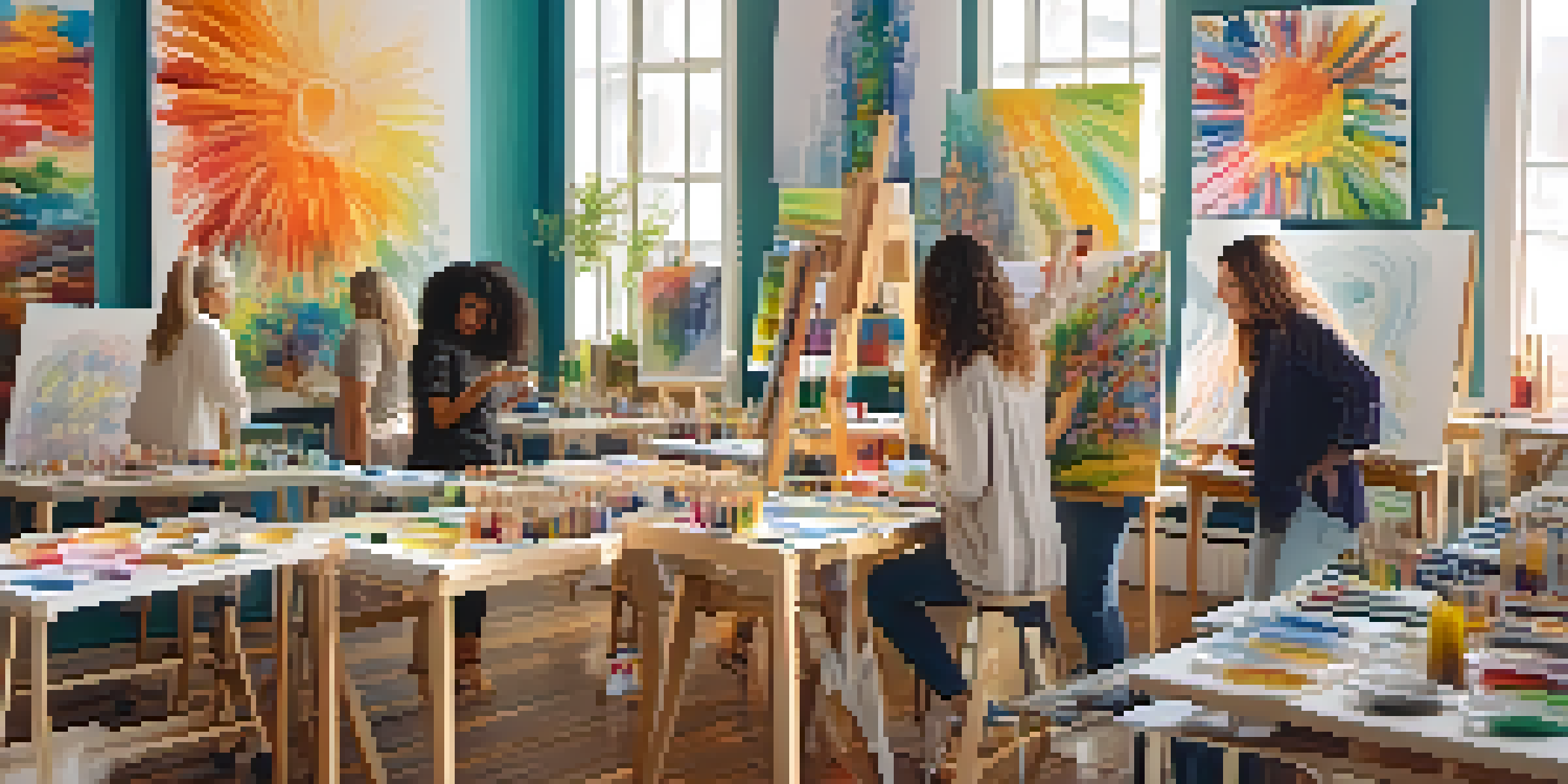Using Painting to Enhance Self-Esteem in Therapy Settings

Understanding Self-Esteem and Its Importance
Self-esteem is a crucial aspect of our mental health, influencing how we perceive ourselves and interact with the world. It reflects our confidence in our abilities and our sense of self-worth. When self-esteem is low, it can lead to feelings of inadequacy and anxiety, impacting various areas of life.
Art is not freedom from discipline, but disciplined freedom.
In therapy, fostering self-esteem is essential for helping individuals overcome challenges and reach their potential. A positive self-image can empower people to take risks, pursue goals, and build healthier relationships. Thus, finding effective methods to enhance self-esteem is a priority for many therapists.
One such method that’s gaining popularity is the use of painting in therapy. This creative approach not only allows individuals to express themselves but also serves as a powerful tool for building self-esteem and self-acceptance.
The Therapeutic Benefits of Creative Expression
Engaging in creative activities, like painting, can have profound therapeutic benefits. It provides a safe space for individuals to express their thoughts and emotions without the constraints of verbal communication. This can be particularly helpful for those who struggle to articulate their feelings.

Painting encourages exploration and experimentation, allowing individuals to break free from perfectionism. By focusing on the process rather than the outcome, people can discover the joy of creation, which can significantly enhance their self-esteem. They learn to appreciate their unique perspective and abilities.
Self-Esteem Boost Through Creativity
Engaging in painting can significantly enhance self-esteem by allowing individuals to express themselves and experience personal growth.
Additionally, the act of creating art can be meditative, helping to reduce anxiety and promote relaxation. This calming effect can lead to a more positive self-view and improved emotional stability, further supporting the therapeutic process.
How Painting Facilitates Self-Discovery
Painting can serve as a mirror, reflecting our inner thoughts and feelings. When individuals paint, they often uncover aspects of themselves they weren’t consciously aware of. This self-discovery can be enlightening and validating, leading to increased self-acceptance.
Every artist was first an amateur.
Through the process of choosing colors, shapes, and subjects, individuals can express their identities and experiences. This expression can help them make sense of their emotions and life experiences, promoting personal growth and self-awareness. It’s like embarking on a journey within oneself, where the canvas becomes a guide.
Moreover, sharing their artwork in a therapeutic setting can foster connection and understanding. When individuals discuss their paintings, they often gain insights from both the therapist and peers, reinforcing their sense of belonging and self-worth.
Building Confidence Through Artistic Achievement
Creating a piece of art can give individuals a sense of accomplishment, which is vital for boosting self-esteem. Completing a painting, regardless of the artistic skill level, allows individuals to see tangible results from their efforts. This achievement can be a significant confidence booster.
In therapy, celebrating these small successes can help clients recognize their strengths and capabilities. As they receive positive feedback from their therapist and peers, they begin to internalize this validation, reinforcing their belief in themselves. It’s a wonderful way to cultivate a positive feedback loop.
Art as a Tool for Self-Discovery
Painting serves as a mirror for self-reflection, helping individuals uncover emotions and insights that promote self-acceptance.
Additionally, engaging in art can encourage individuals to set and pursue goals, both in and out of therapy. This proactive approach to life not only enhances their self-esteem but also instills a sense of agency and control over their circumstances.
Creating a Safe Space for Vulnerability
Therapy can often feel intimidating, but incorporating painting helps create a safe, welcoming environment. By focusing on art, individuals may feel less pressure to conform to traditional therapy norms and can express themselves more freely. This can reduce anxiety about sharing personal experiences.
A painting session can act as a comforting distraction, allowing individuals to ease into vulnerability. As they immerse themselves in the creative process, they may find it easier to open up about their feelings and experiences. This transition can enhance the therapeutic relationship, fostering trust and connection.
Moreover, the non-judgmental nature of art offers a unique opportunity for individuals to explore their emotions without fear of criticism. This safe space encourages authenticity, which is essential for meaningful therapeutic progress.
Incorporating Painting into Therapy Sessions
For therapists looking to incorporate painting into their practice, it’s essential to start with a clear intention. Setting specific goals for each session can help guide the process and ensure that it aligns with the client’s therapeutic needs. Whether the focus is on self-exploration or emotional expression, clarity is key.
Providing a variety of materials can enhance the experience, allowing individuals to experiment with different tools and techniques. This exploration can lead to unexpected insights and a greater sense of freedom in their creative expression. Encouraging clients to choose colors and subjects that resonate with them can further personalize the experience.
Creating Safe Spaces in Therapy
Incorporating art in therapy fosters a welcoming environment where individuals can express vulnerability without fear of judgment.
Finally, it’s important to create a reflective space where individuals can discuss their artwork afterward. This can help them articulate their feelings and thoughts about the process, deepening their understanding of themselves and reinforcing the therapeutic benefits of painting.
Real-Life Success Stories of Painting in Therapy
Many therapists have witnessed transformative experiences when integrating painting into their sessions. For instance, a young adult struggling with anxiety found solace in painting during therapy. As they painted, they gradually expressed feelings of fear and self-doubt, leading to significant breakthroughs.
Another case involved a child dealing with grief. Through painting, they were able to convey their emotions about losing a loved one in ways words could not capture. The therapeutic process not only facilitated healing but also helped the child articulate their feelings to their family.

These stories highlight the profound impact painting can have in therapy settings. By embracing creativity, individuals can uncover their emotions, build self-esteem, and embark on a journey of self-discovery and healing.